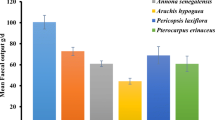Abstract
The limited availability of food, together with the constraints that traditional management systems impose on the natural foraging behaviour of donkeys, often results in severe under-nutrition. Few studies have been conducted into the digestibility of different forages and little information exists on nutritional requirements of donkeys. In order to measure digestible energy requirements of donkeys under tropical conditions, an experiment was carried out at the Centre for Research in Agricultural Science (CICA) and the Faculty of Veterinary Medicine of the Universidad Autónoma del Estado de México located in the Toluca valley, Central México. Thirty-two donkeys of a body condition typical for Central México were divided into four groups of 8 animals each according to their sex and live weight: group 1 (Gl) comprised male donkeys below the average body weight (102 ± 5 kg); group 2 (G2) comprised male donkeys of average body weight (121.5 ± 4 kg); group 3 (G3) comprised female donkeys below average weight (111.8 ± 5 kg); and group 4 (G4) comprised female donkeys of average weight (127.6 ± 5 kg). A diet of oat straw or maize stover and 15% alfalfa hay was offered to meet exact maintenance requirements. The donkeys were monitored for 13 months. The live weight of all animals was recorded daily in order to monitor whether maintenance requirements were being met. Mean daily digestible energy (DE) requirements were measured during the winter, spring, summer and autumn of 2003–2004. Digestible energy requirements of all four sex and liveweight groups were significantly (p > 0.05) higher during the spring than during the other seasons of the year (13.5, 18.0, 10.4 and 14.3 MJ DE per day during winter, spring, summer and autumn, respectively). Predicted DE requirements of donkeys with a live weight range betweenn 90 and 150 kg using the data from the present study were less than those predicted using scaled-down horse feeding standards.
Similar content being viewed by others
Abbreviations
- ADF:
-
acid detergent fibre
- ADL:
-
acid detergent lignin
- CICA:
-
Centre for Research in Agricultural Science (Universidad Autónoma del Estado de México)
- CP:
-
crude protein
- DE:
-
digestible energy
- DM:
-
dry matter
- DMD:
-
(apparent) dry matter digestibility
- DMI:
-
dry matter intake
- GE:
-
gross energy
- IVD:
-
in vitro digestibility
- LW:
-
live weight
- NDF:
-
neutral detergent fibre
- OM:
-
organic matter
- OMD:
-
(apparent) organic matter digestibility
References
Agbagla-Dohnani A., Cornu A., Noziere P., Besle J, Dulphy J., Doreau M. and Grenet E., 2003. Microbial degradation of rice and barley straws in the sheep rumen and the donkey caecum. Journal of the Science of Food and Agriculture, 83, 383–394
Ankom Technology. Method for determining neutral cellulase plus gamanase (NCGD), http://www.ankom.com
Castelán O.O., Estrada, J., Carretero, L., Vieyra, A., Martínez, N., Cárdenas, S., Arriaga, C. and Mould. F., 2003. Degradation characteristics of maize weeds, used as forage in smallholder maize-livestock production systems of Central México, in different growing periods. Tropical and Subtropical Agroecosystems, 3, 115–119
Cuddeford D., Pearson R.A., Archibald R.F. and Muirhead R.H., 1995. Digestibility and gastro-intestinal transit time of diets containing different proportions of alfalfa and oat straw given to Thoroughbreds, Shetland ponies, Highland ponies and donkeys. Animal Science, 61, 407–117
Ewin, W.N., 1997. The Feds Directory-Commodity Products Guide, (Context Publications Ltd, England)
Jung, H.G. and Deetz, D.A., 1993. Forage Cell Wall Structure and Digestibility, (ASA-CSSA-SSA, Madison, USA)
Martin-Rosset, W., Andrieu, J. and Jestin, M., 1996. Prediction of the organic matter digestibility (OMD) of forages in horses from the chemical composition. In: Proceedings of the 47th European Association of Animal Production Meeting, Lillehammer, Norway, p. 295 (abstract)
Pagan, J.D. and Hintz, H.F., 1986. Equine energetics. 1. Relationship between body weight and energy requirements in horses. Journal of Animal Science, 63, 822–830
Pearson, R.A. and Ouassat, M., 1996. Estimation of the live weight and body condition of working donkeys in Morocco. Veterinary Record, 138, 229–233
Pearson, R.A., Archibald, R.F. and Muirhead, R.H., 2001. The effect of forage quality and level of feeding on digestibility and gastrointestinal transit time of oat straw and alfalfa given to ponies and donkeys. British Journal of Nutrition, 85, 599–606
Ram, J.J., Padalkar, R.D., Anuraja, B., Hallikeri, R.C., Deshmanya, J.B., Neelkanthayya, G. and Sagar, V.V., 2004. Nutritional requirement of adult donkeys (Equus asinus) during work and rest. Tropical Animal Health and Production, 36, 407–112
Smith, D.G., 1999. The impact of grazing time allowance on the dry matter intake and foraging behaviour of cattle and donkeys managed under traditional African grazing systems, (PhD thesis, Edinburgh University)
Starkey, P. and Starkey, M., 2004. Regional and world trends in donkey populations. In: P. Starkey and D. Fielding (eds.), Donkeys, People and Development. A resource book of the Animal Traction Network for Eastern and Southern Africa. (ACP-EU Technical Centre for Agricultural and Rural Cooperation (CTA), Wageningen), 10–21.
Tisserand, J.L., Faurie, F. and Toure, M., 1991. A comparative study of donkey and pony digestive physiology. In: D. Fielding and R.A. Pearson (eds), Donkey, Mules and Horses in Tropical Agricultural Development, (CTVM, Edinburgh), 67–72
Van Soest, P.J., Robertson, J.B. and Lewis, B.A., 1991. Methods for dietary fibre, neutral detergent fibre and nonstarch polysaccharides in relation to animal nutrition. Journal of Dairy Science, 74, 3583–3597
Van Soest, P.J., 1994. Nutritional Ecology of the Ruminant, 2nd edn., (Cornell University Press, Ithaca, NY)
Van Soest, P.J., 1996. Allometry and ecology of feeding behavior and digestive capacity in herbivores: a review. Zoo Biology, 15, 455–479
Author information
Authors and Affiliations
Corresponding author
Rights and permissions
About this article
Cite this article
Carretero-Roque, L., Colunga, B., Smith, D.G. et al. Digestible Energy Requirements of Mexican Donkeys Fed Oat Straw and Maize Stover. Trop Anim Health Prod 37 (Suppl 1), 123–142 (2005). https://doi.org/10.1007/s11250-005-9012-3
Issue Date:
DOI: https://doi.org/10.1007/s11250-005-9012-3



